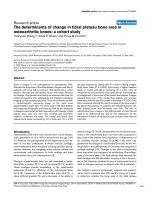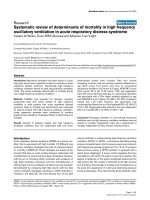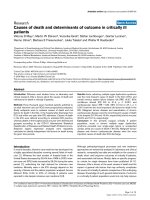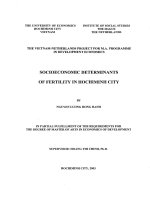Socioeconomic determinants of fertility in HCM City
Bạn đang xem bản rút gọn của tài liệu. Xem và tải ngay bản đầy đủ của tài liệu tại đây (2.06 MB, 79 trang )
THE UNIVERSITY OF ECONOMICS
HOCHIMINH CITY
VIETNAM
INSTITUTE OF SOCIAL STUDIES
THE HAGUE
THE NETHERLANDS
THE VIETNAM-NETHERLANDS PROJECT FOR M.A. PROGRAMME
IN DEVELOPMENT ECONOMICS
SOCIOECONOMIC DETERMINANTS
OF FERTILITY IN HOCHIMINH CITY
BY
NGUYEN LUONG HONG HANH
IN PARTIAL FULFILLMENT OF THE REQUIREMENTS FOR
THE DEGREE OF MASTER OF ARTS IN ECONOMICS OF DEVELOPMENT
SUPERVISOR: HOANG THI CHINH, Ph.D.
HOCHIMINH CITY, 2003
CERTIFICATION
"I certify that the substance of this dissertation has not already been submitted for any
degree and is not being currently submitted for any other degree.
I certify that to the best of my knowledge any help received in preparing this dissertation,
and all sources used, have been acknowledged in this dissertation".
i
ACKNOWLEDGEMENTS
First of all, I would like to express an enormous appreciation to my academic supervisor
Dr. Hoang Thi Chinh for her invaluable guidance along the way ofmakin·g this thesis.
Great gratitude is also expressed to Dr. Karel Jansen and Dr. Youdi Schipper for their
academic advices on the thesis proposal.
Dr. Nguyen Thi Thieng, who gave me huge support in terms of courage, suggestions and
comments from the first stages of doing this research to its completion, is as well truly
appreciated.
I am very grateful to all project teachers and staff for their useful lectures, material and
services.
Many thanks are owned to my classmates, especially Ms. Luong Thi Chung Thuy and
Mr. Luong Vinh Quoc Duy, who lent me a great helping hand in collecting data for this
research.
Last but not least, I thank my dear family for their spiritual encouragement and support
during the time of doing this work.
ii
TABLE OF CONTENTS
CERTIFICATION ............................................................................................................. i
ACKNOWLEDGEMENTS ............................................................................................. ii
TABLE OF CONTENTS ................................................................................................ iii
LIST OF TABLES .................................................................................... ~ ....................... v
LIST OF FIGURES ......................................................................................................... vi
ABBREVIATIONS ......................................................................................................... vii
ABSTRACT .................................................................................................................... viii
Chapter 1: INTRODUCTION ......................................................................................... 1
1.1 PROBLEM STATEMENT ....................................................................................... 1
1.2 OBJECTIVE OF THE THESIS ................................................................................ 3
1.3 RESEARCH QUESTIONS ....................................................................................... 3
1.4 RESEARCH METHODOLOGY .............................................................................. 4
1.5 ORGANIZATION OF THE THESIS ....................................................................... 5
Chapter II: LITERATURE REVIEW AND EMPIRICAL STUDIES ........................ 6
II.l FERTILITY AND ITS MEASURES ....................................................................... 6
II.2 MODELS OF FERTILITY DETERMINANTS .............................. ,....................... 9
II.2.1 The household demand model.. ......................................................................... 9
II.2.2 Synthesis model ............................................................................................... 12
1!.2.3 Bongaarts model .............................................................................................. 15
II.2.4 Reasons for choosing the research model ....................................................... 16
II.3 EMPIRICAL STUDIES ON FERTILITY DETERMINANTS ............................. 17
II.4 CHAPTER OUTLINE ........................................................................................... 22
Chapter III: FERTILITY IN VIETNAM AND HCMC ............................................. 23
III.1 HCMC GENERAL CONDITIONS ...................................................................... 23
III.2 POPULATION ..................................................................................................... 26
III.2.1 Vietnam .......................................................................................................... 26
11!.2.2 HCMC ............................................................................................................ 27
iii
III.2.3 Policies on population and fertility ................................................................ 28
11!.3 FEATURES OF FERTILITY IN VIETNAM AND HCMC ................................ 30
11!.3.1 Trends ............................................................................................................ 30
111.3.2 Socioeconomic differentials ........................................................................... 32
11!.3 CHAPTER OUTLINE .......................................................................................... 37
Chapter IV: DETERMINANTS OF FERTILITY IN HCMC ................................... 38
IV.1 ANALYTICAL FRAMEWORK AND RESEARCH METHODS ...................... 38
IV.1.1 Analytical Framework ................................................................................... 38
IV .1.2 Research Methods .......................................................................................... 41
IV.2 DETERMINANTS OF FERTILITY IN HCMC ............................ ~ ..................... 44
IV.2.1 Descriptive Statistics ..................................................................................... 44
IV.2.2 Regression Analysis ....................................................................................... 52
IV.3 CHAPTER OUTLINE .......................................................................................... 57
Chapter V: CONCLUSION AND RECOMMENDATIONS ..................................... 59
V.1 CONCLUSION ...................................................................................................... 59
V.2 RECOMMENDATIONS ....................................................................................... 60
V.3 FURTHER RESEARCH ....................................................................................... 61
APPENDIX A - QUESTIONAIRE ............................................................................... 62
APPENDIX B .................................................................................................................. 64
APPENDIX C .................................................................................. ~ ............................... 65
BIBLIOGRAPHY ........................................................................................................... 66
iv
LIST OF TABLES
Table III.l: Education Levels. HCMC, 1989-1999 .................................................... 25
Table III.2: Levels of education of population aged over five years. HCMC, 19791999 ........................................................................................................................... 25
Table III.3: TFRs. HCMC, 1989-1999 ....................................................................... 31
Table !11.4: ASFRs and TFRs by urban and rural areas. Vietnam, 1989-1999 .......... 33
Table 111.5: ASFRs and TFRs by urban and rural areas. HCMC, 1999 ...................... 33
Table iV.l: Calculation for sample size ..................................................................... 43
Table IV.2: Description ofvariables ........................................................................... 45
Table IV.3: Distribution ofCEB ................................................................................. 46
Table IV.4: Relationship between fertility and completed years of schooling ........... 50
Table IV.5: Relationship between fertility and household income ............................. 51
Table IV.6: Regression results for CEB ..................................................................... 53
v
LIST OF FIGURES
Figure III.l: Trends ofTFRs. Vietnam, 1959-1999 ...................................................... 30
Figure III.2: Natural Increase Rates(%). HCMC, 1975-1999 ...................................... 31
Figure III.3: Fertility differentials by education attainment. Vietnam, 1999 ................ 34
Figure III.4: Fertility differentials by occupation category. Vietnam, 1999 ................. 35
Figure III.5: Fertility differentials between rural and urban by quintile ....................... 36
Figure IV.l: Fertility changes between rural and urban by age group ......................... 48
Figure IV.2 Fertility changes between rural and urban by women's schooling ........... 49
Figure IV.3: Relationship between fertility and completed years of schooling ........... 50
Figure IV.4: Relationship between fertility and household income ............................. 51
vi
ABBREVIATIONS
ASFR
Age-Specific Fertility Rate
CBR
Crude Birth Rate
CEB
Children Ever Born
GFR
General Fertility Rate
GSO
General Statistics Office
HCMC
HoChiMinh City
HSCPH
HCMC Steering Committee for Population and Housing Census
01/4/1999
HSO
HoChiMinh City Statistics Office
NCPF
National Committee for Population and Family Planning
OLS
Ordinary Least Squares
TFR
Total Fertility Rate
VNDHS
Vietnam Demographic and Health Survey
VLSS
Vietnam Living Standard Survey
vii
ABSTRACT
This thesis examines the effect of female schooling and household income on fertility in
HoChiMinh City using data collected from the personal survey in 2003. The first method
of descriptive statistics presents the correlations between fertility and female schooling,
household income and location by summarized data and graphs. The second method of
regression analysis estimates a reduced form equation in which the number of children
ever born is regressed on the mother's age and completed years of schooling, household
income and area variables. The equation is estimated. using ordinary least squares (OLS).
The study reveals some findings as follows: schooling reduces fertility, while income
raises it. Urban residence is negatively associated with fertility. Parts of population who
still have high fertility rates are of low levels of education or are living in rural districts.
From these findings, some recommendations are suggested for enhancing population and
family planning programs in order to reach the objective of fertility reduction.
viii
Chapter I: INTRODUCTION
1.1 PROBLEM STATEMENT
Population is one of the biggest concerns to development economists and policy makers
because of its extensive impact on the economic development (Ray, 1998:295).
Population growth is strongly determined by fertility level (Tran, 1999:106). The world
history has experienced fluctuation in population growth and fertility level, such as an
unprecedented and unanticipated 'baby boom' followed by an almost equally startling
'baby bust'. And population controlling policies have also been changing from time to
time, different from one country to another, from incentives to childbearing in the
developed countries facing low fertility in the Great Depression to measures of lowering
the fertility rate in the less-developed countries in the post-World War II era (Eatwell et
al, 1987 :302). Studying fertility behavior will provide us insights into how population is
changing around us. Moreover, a better understanding of fertility level and pattern will
significantly assist the process of policy making. Policies influencing fertility rate could
in turn have an effect on population growth. On the other hand, according to Nguyen
(200 1), mastering of fertility level and pattern will provide more accurate projections. For
example, to estimate budget on primary education, the analysts need to figure out the
number of children going to primary school, which could be accessed through fertility
studies. Projection of labor force is likewise worked out (Nguyen, 2001:1 ).
In the case of Vietnam, a developing country, explosive population growth and high
fertility rate attribute to a wide range of social, economic, and ecological problems
(NCPF, 1999:3); and the current population growth is not in line with the development
1
process, causing unbalances in terms of accumulation, consumption, occupation,
education, health care and public security (Tran, 1999:1 08).
Vietnam had a large population of 79,715 million persons in 2002 (HSO, 2003:237), a
fast population growth at 2.13% per year (Tran, 2002: 18). The total fertility rate (TFR)
in 1999 was 2.34 children per woman (GSO, 2001 b: 46). In his study, Shapiro (1999)
found that "Despite the progress is being made in reducing fertility, population growth is
still fairly rapid and there is considerable concern about the potential adverse
consequences for the Vietnamese economy of continued high fertility and rapid
population growth" (Shapiro, 1999: 123). Moreover, fertility rates diverge among
regions, groups of different education or income levels (GSOb, 2001: 52, 68). Fertility
rates remain high in some parts of population, such as rural areas, or women who receive
low education. Therefore, Vietnam's five-year plan of 2000-2005 aims at reducing the
population growth rate to 1.22% (Vietnamese Communist Party, 2001: 51), and the key
objective of Strategy of Population and Family Planning in the case of 2001-2010 focuses
on fertility reduction (NCPF, 2000:6).
As the most commercialized and populous city of the country, HoChiMinh City has
similar characteristics in population problems with those of the whole country. Although
the its total fertility rate is the least in the country and significantly declining, in 1999 it
was only 1.41 children per woman, there are still distinct differentials between various
parts of its population as mentioned above (HSCPH, 2000:5). Therefore, the questions
raised here are if there are any parts of population have high fertility level within the city
and how to identify them. In order to answer these questions to regulate the rate, it is
2
necessary to detect socioeconomic factors that affect the fertility level. That is the central
purpose of this research.
I.2 OBJECTIVE OF THE THESIS
The thesis is meant to do the research on fertility rates of ever-married women living in
HCMC, aged from 15 to 49 years, to find out major socioeconomic factors that affect
fertility levels in HCMC and which are the most important ones. Then, the fertility
differentials will be analyzed to identify which parts of population in HCMC still have
high fertility rates. Based on results of the analysis, policies on fertility and related
matters will be suggested to improve the planning family program of Vietnam and
HCMC, particularly to reduce fertility levels in highly reproductive areas in HCMC.
I.3 RESEARCH QUESTIONS
With the objective cited above, my thesis aims at answering the following questions:
I. Is there a negative effect of the completed years of schooling of women on the \._/
fertility rate in HCMC in 2003?
2. Is there a negative effect of the household income on the fertility rate in HCMC in
2003?
~
As we will see in the literature review m chapter two, according to the theory of
household demand, the number of children demanded varies inversely with the relative
price of children and directly with household income. Children are seen as requiring
inputs of goods and time, and the price of children depends on the prices of these inputs.
3
J
The opportunity cost of the time input into children is proxied by mother's schooling. As
a result, when women's education is high, demand for children will reduce (Eatwell et al,
1987:303). A weak positive influence of income on fertility could be offset by a stronger
negative price effect or quality-quantity tradeoff (Chenery et al, 1988:504). The results of
empirical works supported the negative effect of education on fertility but revealed the
complexity of the correlation between fertility and income. Therefore, the research
hypotheses are as follows:
1.
There is a negative effect of the completed years of schooling of women on the
fertility rate in HCMC in 2003.
2. There is a negative effect of the household income on the fertility rate in HCMC in
2003.
1.4 RESEARCH METHODOLOGY
All types of data are utilized in the thesis. The tertiary data (reports relating to population
and fertility issues) and secondary data (HSO 2002, GSO 2001, HSCPH 2000, VDHS
1997) will be used to analyze the current status of fertility in Vietnam and in HCMC.
The primary data set comes from the personal survey to test the research hypotheses. The
research questions will be handled by using descriptive statistics and OLS regression.
The first approach studies data of each variable and separate correlations between fertility
rate and determining factors, using numerical summaries and graphs. The latter estimates
a multivariate model to examine factors affecting fertility.
4
1.5 ORGANIZATION OF THE THESIS
The thesis is divided into five chapters.
Chapter one introduces the problem statement, objective, research questions, hypotheses,
methodology of the thesis.
Chapter two explores the literature related to fertility issues, such as key concepts and
theories of fertility. Reasons for choosing the research model are also stated in this
chapter. The last section is to review the empirical studies regarding to the subject.
Chapter three draws a general picture about fertility status in Vietnam and HCMC.
Chapter four is the analysis of socioeconomic determinants of fertility rate in HCMC,
basing on a chosen analytical framework and methodology which are as well presented in
this chapter.
Chapter five gives out conclusion, recommendations and further research;
5
Chapter II: LITERATURE REVIEW AND EMPIRICAL STUDIES
This chapter consists of three sections. In section 11.1, definitions of fertility and its
measures are presented. Section 11.2 is a literature review on leading theories of fertility.
It also explains the reasons for choosing the theory that motivates the model used in the
thesis. The last section 11.3 provides empirical studies on determinants of fertility.
II.l FERTILITY AND ITS MEASURES
*Fertility:
In the jargon of demographers, there are two terms which are often used synonymously,
but in fact they are different from each other. Fecundity is the physiological ability to
reproduce. Fertility is the realization of that potential, the actual birth performance as
measured by the number of off-spring (Peterson, 1999:49). Some measures of fertility are
cited in NCPF (1999:27), Tran (200 1:60) and Nguyen (200 1:7), as follows:
* Crude Birth Rate (CBR):
CBR presents the number of births during the reference period (B) per thousand midperiod population ( P ).
CBR = ~ 1000
p
Because this measure is simple, easy to calculate, to compare between different areas, it
is widely used in demographic researches. However, it suffers from some problems. It is
affected by time and space, depending on many other factors such as intensity of
6
reproductive process, age and sex structure of population, and even marriage patterns.
Consequently, CBR is just an indicator which approximately reflects the actual fertility
rate.
*General Fertility Rate (GFR):
GFR refers to the number of live births during the period (B) per thousand women in
reproductive ages W(15- 49). The reproductive ages here are from 15 to 49.
GFR=
B
1000
W(15- 49)
GFR indicates fertility rate more accurate than CBR because it restricts the denominator
to women at risk of pregnancy while the numerator includes the same live births in the
period as in the calculation of CBR. However, it is still affected by the age distribution of
women in childbearing age.
*Age-Specific Fertility Rates (ASFRs):
ASFRs are calculated by dividing the number of births to women in a specific age group
(Bi) by the number of women in that age group PF(i) . ASFRs are measures of fertility
which are more accurate than two above indicators. They are useful to understand the age
pattern of fertility.
ASFR(i) = B(i) 1000
PF(i)
7
* Total Fertility Rate (TFR):
In demographic research, people often use the total fertility rate. TFR is defined as the
number of children a woman would bear during her lifetime if she were to experience the
age-specific fertility rates prevailing during the reference period. For the age range 15-49,
TFR is calculated by summing the age-specific fertility rates for age group index (5 year
age groups) and multiplying by 5:
TFR=5L
B(i)
PF(i)
This value is considered the most precise indicator and an improved summary measure of
fertility. It is unaffected by the age and sex composition of the population and thus
separate change in actual fertility.
I~
supposes that women do not die during the
reproductive age, so it is not influenced by mortality.
*Children Ever Born (CEB):
Different from the macro measures of fertility mentioned above - which refer to fertility
of population, CEB is a micro measure covering individuals or household. CEB or
cumulative fertility is the cumulative number of live births a woman has had during her
lifetime.
In my thesis, CEB will be used as a dependent variable to figure out the fertility
determinants in HCMC. As a micro indicator, CEB is often employed in studies of micro
fertility behavior because of its simplicity for collecting data. However, according to
8
Nguyen (2001), it has some limitations. Underreporting can result from age misreporting
and omission of children who have died or have left the household. It ignores issues of
timing of births, child spacing, changing fertility and changing determinants (Nguyen,
2001: 12). In order to restrict these limits, researchers could use the indicator of CEB by
recent fertility, i.e. including only children born in a certain amount of period previous to
the survey, for example, one, five or ten years. Nevertheless, even within ten year period,
I face with difficulties in collecting data which contains little variation. In other words,
number of children ever born within recent ten years fluctuates only about one or two
children, this obstructs the research process. For all of these reasons, measure of CEB is
chosen to use in my thesis.
11.2 MODELS OF FERTILITY DETERMINANTS
11.2.1 The household demand model
In her study, Ainsworth (1989) described the model as follows:
In the household demand model of fertility [Becker (1965, 1981)], the household
maximizes a utility function which over children (C), market goods (X) and their leisure
(L):
U=U (C, X, L)
U' >0, U'' <0
(2.1)
The utility function is maximized subject to a household production function for children
and to time and budget constraints. The production of children is described by a linearly
homogeneous production function with time in childrearing (Tc) and purchased child
goods (Xc) as inputs:
9
r > o, r· < o
(2.2)
Time constraint allocates total time (Q) among childrearing (Tc), market production (Tm)
and leisure:
(2.3)
The family faces a full-income budget constraint, i.e. a budget constraint defined in terms
of non-labor income (V) and total value of parents' time which equal to consumption
expenditure. It can be written:
(2.4)
Where w is the market wage; trc is the shadow price of children; Px is the price of other
market goods. The shadow price of children is the sum of the value of the marginal inputs .
in their production:
(2.5)
Where tc is the marginal time input in child production (oTc/oC), Pxc is the price of
purchased child inputs and Xc is the marginal input of purchased goods (oXJoC).
Maximizing equation (2.1) subject to the constraints (2.2) - (2.4) yields a system of
demand equations that can be estimated using ordinary least squares expressing the
demand for children, market goods and leisure as a function of exogenous prices and
income. Children are assumed as normal goods, and then an increase in income will also
raise the demand for children. How then does the model explain the association of high
and rising income with low and falling fertility? According to Chenery et al (1988), there
10
are two possible ways. First is a price effect. A principal component of the cost of
children is the time parents devote to childbearing and childrearing (embedded in 1tc). In
higher income households, wages and parents' opportunity cost of time are relatively
higher. Children are more time intensive than other consumption commodities, their
relative price rises with rising wages. This price effect may offset the positive income
effect associated with higher wages. Second explanation is there is a trade-off between
the quality and quantity of children. Parent will substitute 'quality' of children for high
number of 'quantity' in the production (rearing) and consumption (enjoying) of children
(Chenery et al, 1988:504). As a result, the impact of income on fertility could be
negative. The effect of an increase in wage indicating the effect of an increase in shadow
price of children, proxied by mother's education, is unambiguously negative. The
demand for children and posited signs are sumarized as:
(2.6)
The number of children observed is the result of the interaction between the demand for
and supply of children. The supply of children is biologically determined by the age of
the woman (A) and a variable (u) that measures a woman-specific component of
fecundity [(Rosenzweig and Schuldtz, 1985)]. The supply of children increases with age
but at a decreasing rate, declining absolutely as the woman reaches the biological end of
childbearing.
(2.7)
The reduced form equation for the determinants of fertility includes both demand and
supply-side variables (Ainsworth, 1989: 13).
11
According to Eatwell et al (1987), this approach dominated the economic theory of
fertility since it appearance. It makes fertility, a non-economic area of human behavior, a
valid subject for study by economists. It explains the secular decline in fertility by
assimilating fertility behavior to the micro economic theory of household demand,
household production theory and the allocation of time. However, it cannot explain the
so-called 'natural fertility' regime, the absence of any attempt deliberately to limit
fertility. In other words, so few couples do anything to control their fertility with a chosen
number of children demanded. The synthesis model will deal with this matter.
11.2.2 Synthesis model
A second approach of economists is the so-called "synthesis" model of fertility
[Easterlin, (1978), Easterlin, Pollak and Wachter (1980)]. Like the household demand
model, the synthetic model posits a utility maximizing household which faces a set of
market and shadow prices, a particular household production function. However, the
synthesis model combines this demand-oriented analysis with demographers' modelling
of the supply of children. It also incorporates some aspects of sociologists' emphasis on
the endogeneity of tastes.
The synthesis model posits a utility function:
U = U(Z, N, d, a, 1, e, t; Z*, N*)
(2.8)
Which includes not only commodities (Z) and completed family size (N), but the utility
associated with the frequency of intercourse (a), and the disutility associated with the
length of time over which contraception is practice (9) and its intensity (t), and with
12
infant mortality (d). Z* and N* denote "normal" levels of consumption and family size in
a particular society; the semicolon indicates that the preference ordering over the
variables (Z, N, d, etc.) depends on the value of Z* and N*. The disutility of infant deaths
and the utility of intercourse rule out infanticide and abstinence as means to limit family
size. Preferences play a role in determining use of contraception; societal norms play a
role in determining preference orderings. The variable (I) denotes a vector of "practice"
or societal norms, such as lactation or breastfeeding, appropriate age at marriage,
appropriate period of postpartum abstinence and so forth.
Utility is maximized subject to a budget constraint which includes the cost of fertility
regulation:
f(8, t)
And two production constraints - a birth and a death function:
b = f3 (a, Z, X, I, 8, t,
d
=
~)
D (b, Z, I)
(N = b- d)
Where X denotes goods that are purchased and
~
is the
~ength
of the reproductive span
(Chenery et al, 1988:507).
In short, synthesis model broadens the household income rriodel with two considerations
namely taste influence and 'natural fertility' or 'supply' factors. It stresses two factors as
fertility determinants in addition to the demand for children: the potential supply of
13
children, the number of surviving children parents would have if they did not deliberately
limit fertility; and the costs of fertility regulation (Eatwell, 1987:304). However, because
of the research purpose as well as the limitations in data collecting, some fertility
determinants in this model have to be left for further research.
Both household demand model and synthesis model provide useful insights linking
fertility change to the process of economic development. First, they stress that fertility
behavior in poor economies is rational - the result of an implicit weighing up by parents
of the costs and the benefits of children. In other words, high fertility is due to low time
costs of child care and high costs of fertility regulation. Second, both of them find out
fertility determinants, basing on these factors, policy implications are issued to alter
fertility behavior.
However, these approaches also have some limits as cited in Chenery et al (1988):
The assumption of utility maximization. It is criticized that an increasing degree of
rationality in society as a whole is ignored as a possible explanation of fertility decline.
For example, a decline in the influence of religion could reduce fertility even in the
absence of price changes.
The fact that these are one-period, static model, requiring near perfect information
and full certainty. Neither model deals with the likelihood that fertility decisions are not
made all at once but are sequential. Parents are assumed to have good information on
their lifetime stream of income, on future relative prices of schooling and contraceptives,
and on their own fecundity. They are assumed to have full information about
characteristics of their children such as innate ability, sex, congenital health problems and
14
so on, which could affect subsequent fertility decisions as well as returns to quality
investments. The more educated are expected to be more efficient in use of contraception,
in part because they are better processors of new information. But the sociologists' idea
that diffusion of information about fertility regulation (absent any price changes) could
lower fertility is not incorporated into the model. Finally, parents are assumed to face no
uncertainty about their own emotional response to future children.
The "family" utility function.
In the model, a single utility function is assumed to
embody the preference of husband and wife for number (and quality) of children. Yet
there is evidence that husband and wife do not always agree.
The issue of marginality. This economic micro model of fertility appear more
effective in explaining changes at the margin than in explaining the broad sweep of
fertility change over time. Unless the price and income changes on which they focus are
very broadly conceived - to include institutional and historical factors - the contribution
of economic moael to understanding the broad sweep of fertility change could be limited
(Chenery et al,1988: 511).
11.2.3 Bongaarts model
The fertility determinants discussed in the previous theories are considered as 'basic
determinants". Between these basis determinants of fertility and realized fertility
behavior are the "proximate determinants" of fertility. That is, the basis determinants
influence fertility only indirectly, through their influence on the proximate determinants,
or proximate determinants are seen as determining fertility directly (Shapiro, 1996:125).
15
In order to study proximate determinants of fertility, Le et al (1999) described Bongaarts
model (1978) with the identity
TF = (TF/TM)
X
(TM/TN)
X
(TN/TFC) X TFC
(2.9)
Where TF is the total fertility rate, TM is the total marital fertility rate, TN is the total
natural marital fertility rate (i.e. the marital fertility rate in the absence of contraception
and abortion) and TFC is the total fecundity rate (i.e. the number of children per woman,
after taking into account miscarriages, stillbirths, and natural sterility). Equation (2.9) is
usually rewritten as
TF = Cm X Cc X Ca X ci X TFC
Where Cm (= TF/TM) is an index of marriage, Cc is an index of contraceptive use, Ca is
an index of induced abortion, and Ci (=TN/TFC) is an index of post-partum
infecundability. CcxCa = TMITN. Each index takes on a value between 0 (low fertility
position) and 1 (high fertility position) (Le et al, 1999: 187).
11.2.4 Reasons for choosing the research model
The model used in the thesis is motivated by the household demand model in the tradition
of Becker described in Ainsworth (1989). There are some reasons for this choosing.
Firstly, with the purpose of analyzing socioeconomic determinants of fertility in HCMC,
the first two theories can satisfy the purpose of study. Moreover, according to Guoping
(1999), socioeconomic factors are considered 'fertility influence' which also have an
effect on 'fertility control', i.e. family planning efforts (Gouping, 1999:1). Secondly,
between two of these, the household demand model is found more appropriate when it
16









